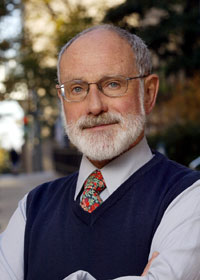Q&A: Male Circumcision and HIV Prevention (web article)

On December 13, the National Institute of Allergy and Infectious Diseases (NIAID) announced the latest scientific evidence demonstrating that medically performed circumcision significantly reduces a man’s risk of acquiring HIV through heterosexual intercourse. NIAID stopped two clinical trials in Kisuma, Kenya, and Rakai, Uganda, after an interim review of data from the trials showed that circumcised men were half as likely to acquire HIV relative to uncircumcised men.
Ronald Gray, MBBS, MSc, the William G. Robertson Professor of Reproductive Epidemiology at the Bloomberg School of Public Health, led the investigative team responsible for the Uganda trial. The trial involved 4,996 HIV-negative heterosexual men who were randomly selected to be circumcised by trained medical professionals or were assigned to a control group and were not circumcised.
Tim Parsons, director of Public Affairs, spoke with Gray about the trial and its findings.
Question: The Uganda and Kenya trials and an earlier South African study have all shown that circumcision provides men partial protection against HIV. What is the significance of this finding and what does it mean for HIV prevention?
Answer: Since the development of antiretroviral drugs in the mid-90s, this is the first major breakthrough supported by unassailable evidence for a preventive measure. If we can implement programs to provide circumcision in those countries where it is an uncommon practice and where most HIV transmission is heterosexual, we believe we could have a fairly major impact on the epidemic. Statistical models suggest we could abort this epidemic over the next 10 to 20 years. That would be by both adult circumcision in the short term and neonatal circumcision in the long term.
It is very encouraging and hopeful news, at least in some parts of the world, that we will be able to abate, if not ultimately end, this epidemic. On the other hand, we are very concerned that people could become complacent and increase their risk behaviors, which we know could negate any benefits from the surgery.
Question: Are you afraid men will think they are impervious to HIV if they are circumcised?
Answer: We have a mantra: Protection is partial. Secondly, we only know the duration of this benefit for two years. We have to do more studies to see if the protection lasts a lifetime. People still have to practice safe sex either by abstaining or being faithful to a partner and using condoms.
Question: Does male circumcision confer any protection for women from HIV?
Answer: We currently have an ongoing trial to answer that question. It won’t be finished until 2008. The results will be of paramount importance. If there is a benefit in both sexes, this intervention could have a much bigger impact.
Question: Will we see male circumcision become policy?
Answer: The World Health Organization (WHO), other health agencies and foundations are trying to meet in January to review all of the evidence and come up with policy. There will be policy guidelines that come out of the WHO, but the ultimate decision will be up to each country. We’re hoping that a policy can be agreed upon internationally. We’ve already heard that a number of major funding sources like PEPFAR (President’s Emergency Plan for AIDS Relief) are looking at investing in scaled-up circumcision programs.
We have to focus on adult circumcision now in order to get short term reductions in HIV. The ultimate goal would be to provide neonatal circumcision.
Question: Now that the trial has stopped early, what do you plan to do in Uganda?
Answer: In Uganda, for the immediate future, we plan to offer our facilities to the ministry of health and to NGOs as a training center. We’ve had more experience with adult male circumcision than anyone else in the country. We are going to train personnel as quickly as possible to perform this surgery. How this will be implemented is still under discussion. Doctors could be trained to provide the surgery in Uganda’s medical centers where they have basic surgical facilities. In more rural areas, we could train teams who would go out and set up surgery theaters to perform this procedure safely.
What we are all trying to avoid is having poorly-trained or untrained general practitioners doing this surgery, because we know it is very unsafe in those hands. Another important issue we are stressing is the need for proper follow-up care. You have to see these patients after surgery to avoid serious complications.
Question: Why was the trial stopped early?
Answer: The trial was stopped early because at an interim analysis, the independent Data Safety Monitoring Board determined that there was a significantly reduced risk of HIV in the circumcised men. If you are seeing benefits from an intervention, you are ethically obliged to provide that intervention to the control group. Once you’ve reached the point where, in a statistical sense, where you are as certain as possible, you need to stop. However, trials that are stopped prematurely tend to show bigger effects than subsequent studies, so we need to continue surveillance in these men to determine whether benefits are sustained, and whether there may be increases in risk behaviors because men or their partners think they are protected by circumcision.
Question: Will your findings have any implications on the prevention of HIV in United States?
Answer: The United States already has a high proportion of circumcised men—about 60 percent. There are no trials in the U.S., but a number of observational studies suggest that circumcised men are at lower risk for HIV even if they are having homosexual relationships, but the body of evidence in the U.S. is much smaller than it is for Africa. It will be up to groups like the Centers for Disease Control and Prevention to determine if these African studies have any application in the U.S.
Public Affairs media contacts for the Johns Hopkins Bloomberg School of Public Health: Tim Parsons or Kenna Lowe at 410-955-6878 or paffairs@jhsph.edu.